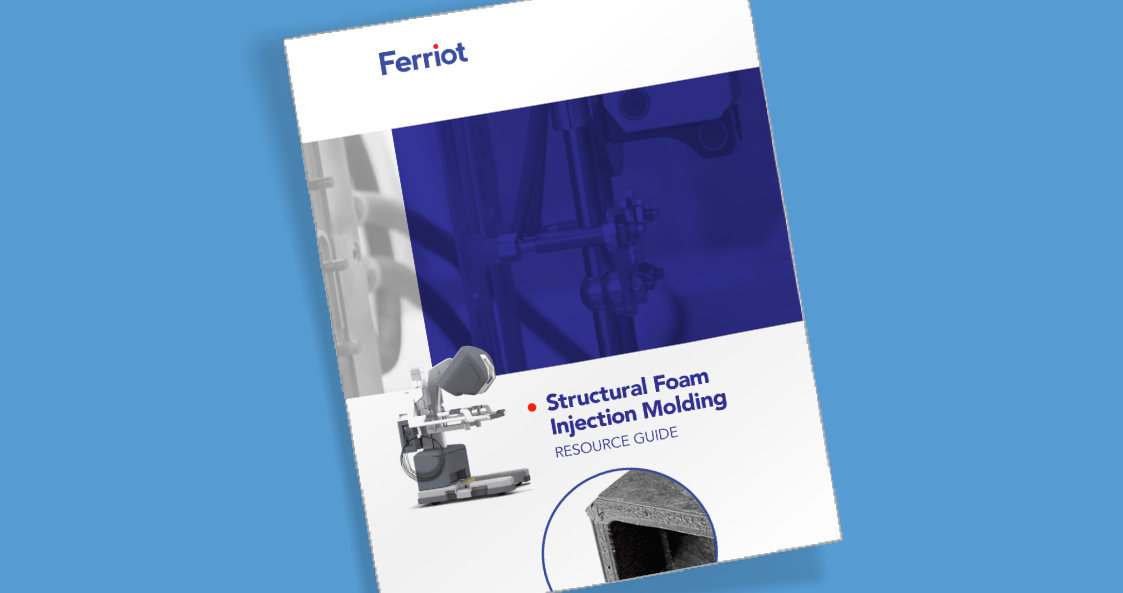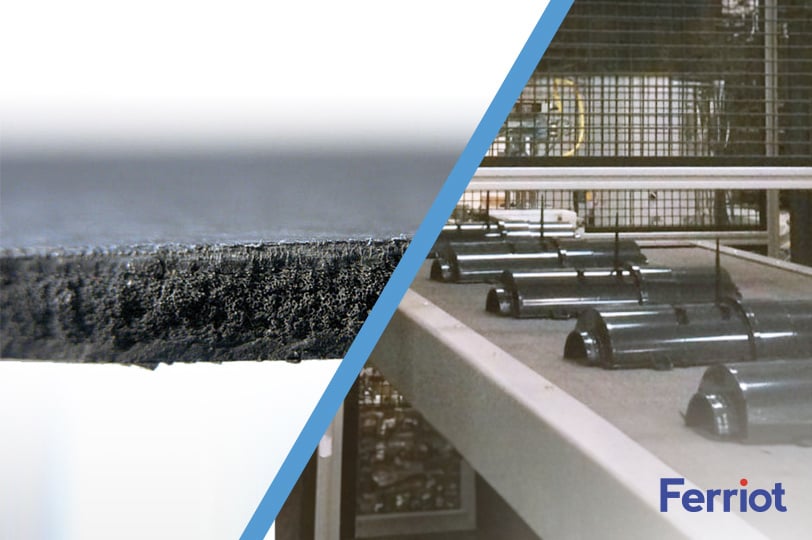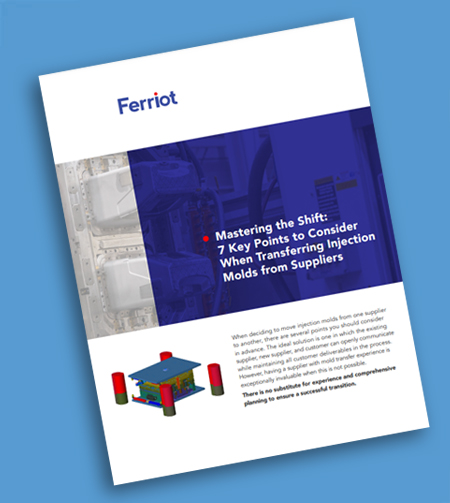Design engineers responsible for creating equipment enclosures often face the challenge of choosing the best manufacturing process for custom injection molded parts. Structural foam and straight injection molding are two popular options. Ferriot practices both methods of fabrication and can offer its expertise to help determine which option will best suit any given application, to meet your project’s objectives and specifications.
Factors that design engineers must consider regardless of the part requiring manufacturing include tooling costs, production volume, material selection and part complexity. The chosen injection molding method and plastic injection molder must also be capable of producing parts that meet the required quality standards and tolerances, as well as production timelines and deadlines. Careful evaluation of the advantages and disadvantages of each method should be weighed carefully against the specific project requirements.
What defines structural foam molding and injection molding?
Structural foam injection molding involves injecting thermoplastic material into a mold. The packing stage is augmented with a chemical blowing agent mixed with the resin. Heat triggers the chemical blowing agent. It expands the material, creating a microcellular structure at the core of the object or product, with an integral outer shell or skin.
Structural foam can be used for parts ranging in size from small to large but is particularly well-suited for larger parts with thicker walls. The cost-effectiveness of the process increases with larger production runs, to spread out the impact of the tooling cost and production set up time.
This results in a part that has:
- High strength to weight ratio: the foam core reduces the weight of the part while maintaining its strength and rigidity. While actual weight savings can vary, parts built using structural foam molding can be 10-30% lighter than other parts. The integral skin contributes to added strength and the entire process creates parts with low stress.
- Cost effectiveness: the process can manufacture large parts for a relatively low cost.
- Good dimensional stability: the level of stability of the finished part shows good resistance to warping and/or distortion.
- Good thermal and acoustic insulation: the foam core lends the finished piece excellent thermal and acoustic insulation properties making them useful in underground and outdoor applications.
- A few of the limitations of structural foam manufacturing for design engineers to consider include: Longer cycle times: compared to other manufacturing methods, this process can take longer than other types of injection molding methods, as the foam core takes additional time to expand and fill the mold.
- Produces a swirling pattern on the surface which might not be desired where cosmetic finishes are required but can be sanded and painted when needed.
Traditional injection molding is typically done in two stages. There’s an injection stage where melted thermoplastic is injected into a mold, and a packing stage where pressure is built, and as the molten material solidifies, it takes on the shape of the mold cavity.
Straight Injection molding is ideal for small to medium-sized parts that require tight tolerances and a smooth surface finish. It is also often used for parts that require high production volumes, as it can be automated for efficient and consistent production. This process offers design engineers:
- High production efficiency: The process is highly automated and can produce large quantities of parts with consistency and accuracy.
- High accuracy and precision: Parts can be created within tight tolerances and with intricate geometries.
- Versatility: Injection molding can produce a wide range of parts from small components to large pieces with complex structures.
- Cost efficiencies over time: Once the mold is set up, the process runs automatically, requiring minimal labor.
Some of the limitations of plastic injection mold manufacturing can include:
- High upfront tooling costs: The design and particularly tooling can be expensive, with costs rising alongside the size of the piece, or for smaller production runs.
- Long lead times: The tooling and mold design can take several weeks or even months.
Factors that tip the balance to one method over another
As a custom injection molder with broad expertise in multiple methods of fabrication, we can point our customers to structural foam molding when traditional injection molding may not meet part design requirements.
The structural foam process creates parts with a high strength-to-weight ratio and is often used for large parts and in metal to plastic replacement.
Structural foam molding also scales well, allowing large or bulky parts to be manufactured while still retaining the superior production speed offered by injection molding. Regardless of size, structural foam parts can be worked post-production in a manner similar to parts constructed of wood or metal. The surface of a finished part is smooth, offering the potential of easy cleaning and can be painted over.
An additional benefit to parts manufactured using structural foam molding is part durability. As a result of the difference in process, parts built employing structural foam molding are sturdy while remaining rigid, and possess greater internal flexibility than parts built using traditional injection molding.
There are many ways to achieve cost savings when considering structural foam:
- Design flexibility allows for part consolidation – stronger, greater wall thickness, lighter weight.
- There is great flexibility in resin selection as even commodity resins can be used.
- The low-pressure process allows large parts to be produced with low tonnage machines which are less costly to run
- Converting a metal part to a plastic part can save weight and manufacturing cost.
Ferriot employs structural foam molding to build a variety of parts, including gas pump front facia. Alongside durability, material options available for structural foam molding also means a finished product can be chemical resistant and/or offer electrical or thermal insulation, suitable for outdoor applications.
Working with an experienced injection molding company
Ferriot has focused on thermoplastic injection molding since the late 1940s, earning a leadership position among plastic injection molding companies due to our focus on quality and service. Our clients turn to us for professional assistance that spans the entire project lifecycle from product design assistance to custom mold design and manufacturing, resin selection, custom injection molding, painting and assembly.
At our manufacturing facilities we offer painting and decorating as part of our value-added services. Within this category, we provide EMI/RFI Shielding of parts, to protect medical equipment and other devices from electromagnetic and radio frequency interference. Methods employed for medical injection molding can successfully transfer to supplying similar protection for sophisticated business and technical equipment as well.
In conclusion, design engineers should work with their custom molder to evaluate the specific requirements of their equipment enclosures to determine whether structural foam or injection molding is the best process for their custom injection molded parts. Structural foam is ideal for larger parts that require strength and durability with a lower weight, while injection molding is ideal for smaller parts that require tight tolerances and a smooth surface finish.
Considering structural foam molding as an alternative solution? We encourage you to contact us to discover how structural foam molding can benefit your business.
Learn more:
- What is Structural Foam Injection Molding?
- Structural Foam Injection Molding: A Miracle Process
- Structural Foam Molding Produces Lighter, Stronger Parts at Lower Cost
- Getting Structural Foam Molding Right Takes More Than Just Blowing Bubbles

Download our Structural Foam Injection Molding Resource Guide Today!



